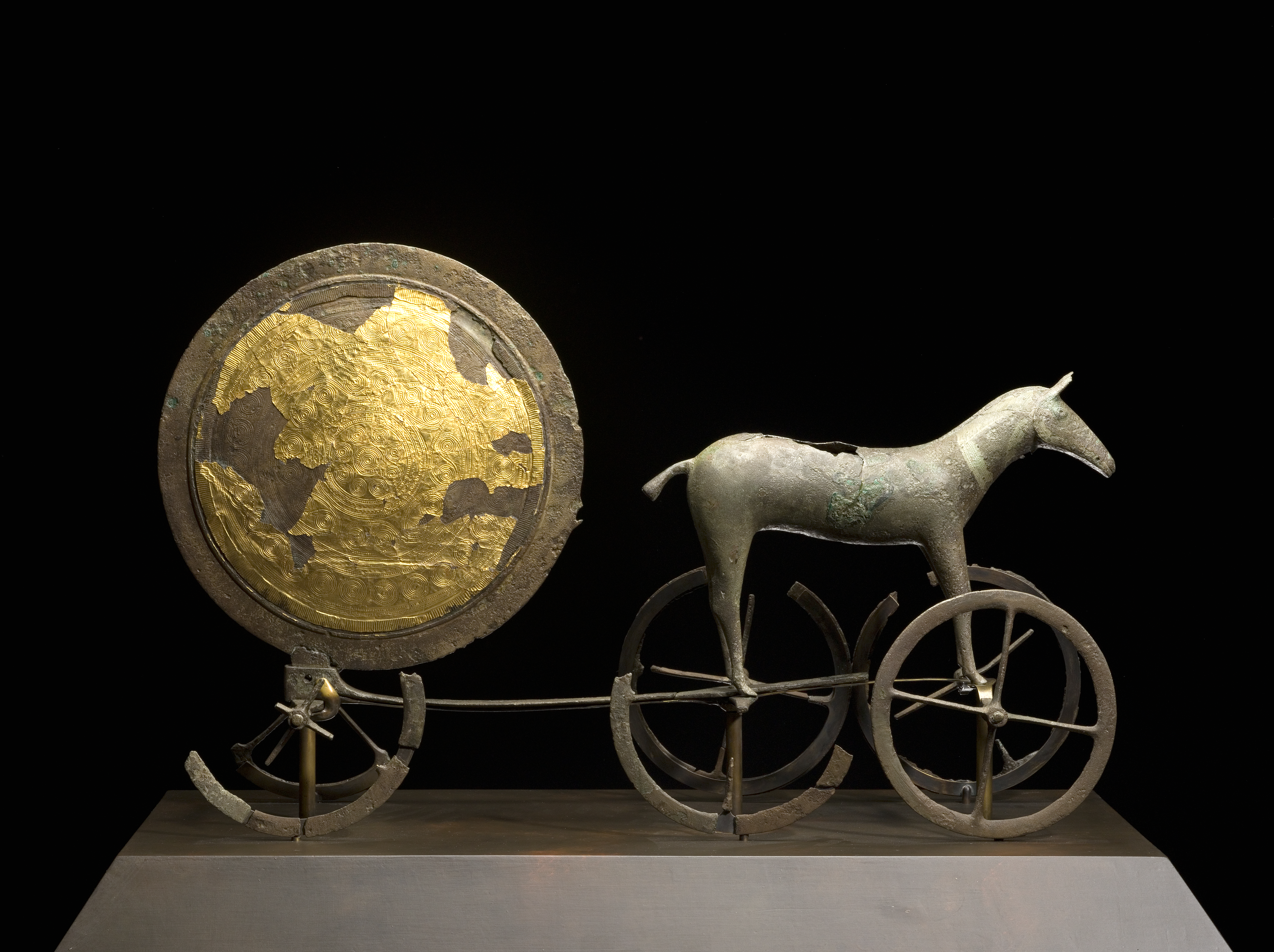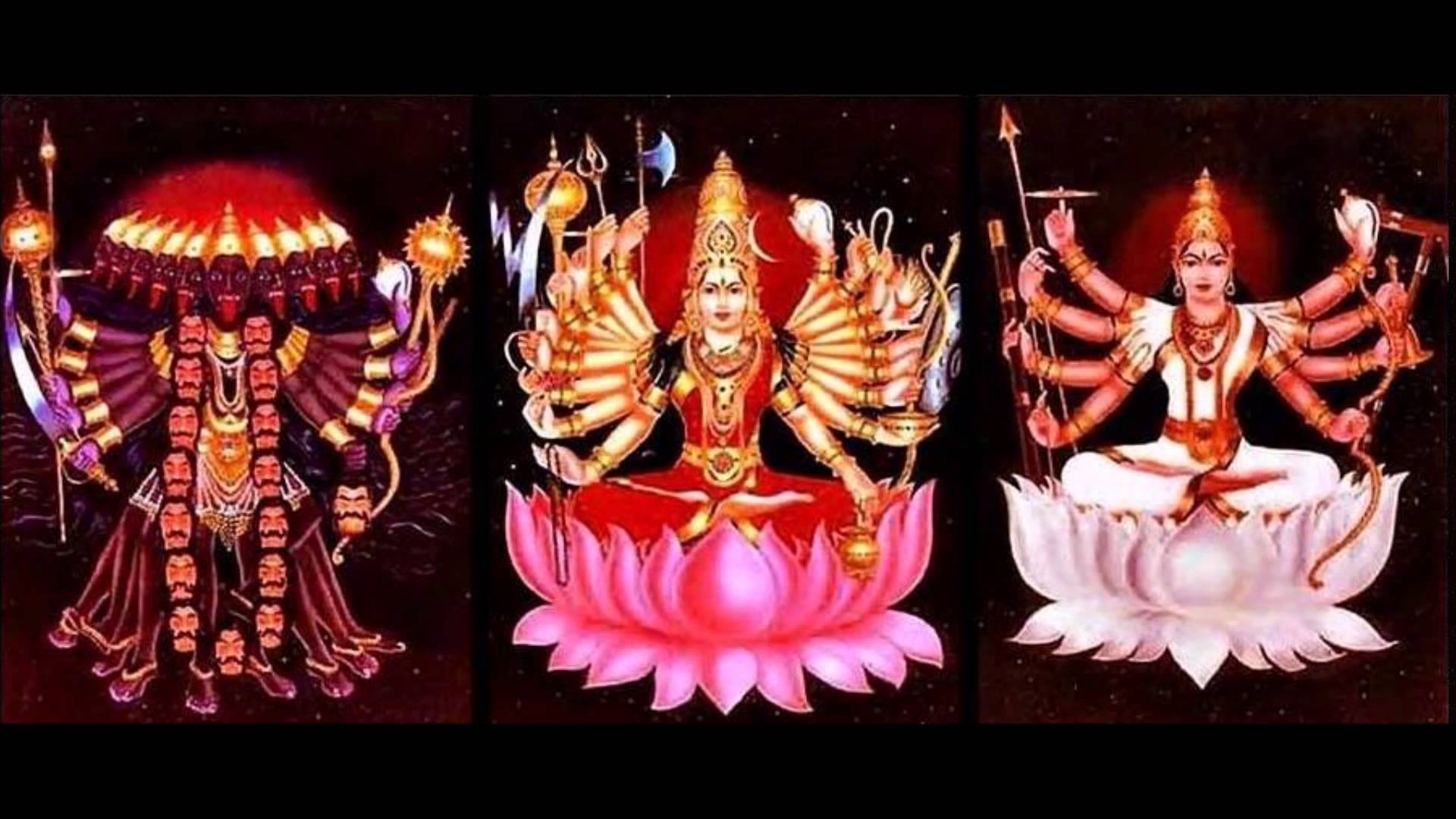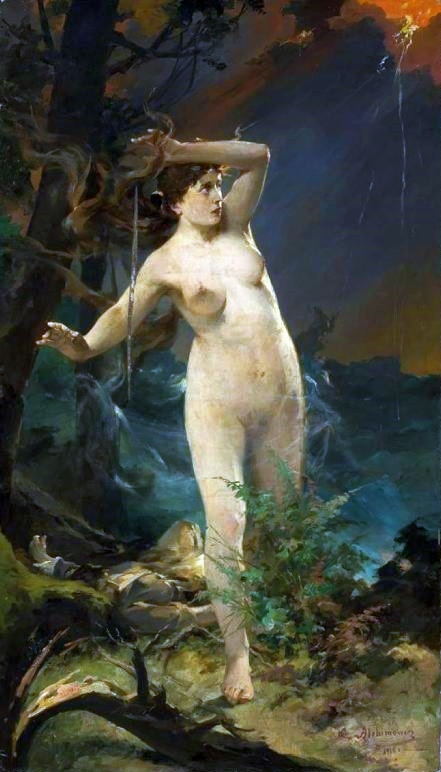|
Fates
The Fates are a common motif in European polytheism, most frequently represented as a trio of goddesses. The Fates shape the destiny of each human, often expressed in textile metaphors such as spinning fibers into yarn, or weaving threads on a loom. This trio is composed of sisters who go by the names Clotho, Lachesis, and Atropos (also known as the daughters of Zeus and Themis). These divine figures are often artistically depicted as beautiful maidens with consideration to their serious responsibility: the life of mortals. Poets typically express the Fates as ugly and unwavering, representing the gravity of their role within the mythological and human worlds. Individual roles The Moirai, meaning "allotted portion" or "share", separated each sister into a different role in order to handle the fates of humans. The Fates were expected to appear within three days of a mortal's birth. Clotho was the first of the three, known as "the spinner", due to the fact that she would weave t ... [...More Info...] [...Related Items...] OR: [Wikipedia] [Google] [Baidu] |
Motif (folkloristics)
The ''Motif-Index of Folk-Literature'' is a six volume catalogue of motifs, granular elements of folklore, composed by American folklorist Stith Thompson (1932–1936, revised and expanded 1955–1958). Often referred to as Thompson's motif-index, the catalogue has been extensively used in folklore studies, where folklorists commonly use it in tandem with the Aarne–Thompson–Uther Index, an index used for folktale type analysis. As standard tools The motif-index and the AT or ATU indices are regarded as standard tools in the study of folklore. For example, folklorist Mary Beth Stein says, "Together with Thompson's six-volume ''Motif-Index of Folk-Literature'', with which it is cross-indexed, ''The Types of Folktale'' constitutes the most important reference work and research tool for comparative folk-tale analysis. Alan Dundes who was an outspoken critic also said substantially the same thing, without confining the application to comparative studies: "he indicesindex consti ... [...More Info...] [...Related Items...] OR: [Wikipedia] [Google] [Baidu] |
Asphodel Meadows
The Asphodel Meadows is a section of the ancient Greek underworld where ordinary souls are sent to live after death. Later depictions The Asphodel Meadows is most probably where the souls of people who lived mediocre lives remain. Its relationship to other places in the Greek afterlife remains uncertain. For later Greek poets the very ancient pre-Homeric association of the asphodel flower with a positive form of afterlife as well as the enlarged role of Elysium as it became the destination of more than just a few lucky heroes, altered the character of the meadows. Greek poets who wrote after Homer's time describe them as untouched, lovely, soft and holy. Such an evolutionary change is quite common: "Like most cultures throughout human history, both ancient and modern, the Greeks held complex and sometimes contradictory views about the afterlife". Some depictions describe it as a land of utter neutrality. That is, while the inhabitants were in life neither good nor evil, so they ... [...More Info...] [...Related Items...] OR: [Wikipedia] [Google] [Baidu] |
Proto-Indo-European Mythology
Proto-Indo-European mythology is the body of myths and deities associated with the Proto-Indo-Europeans, the hypothetical speakers of the reconstructed Proto-Indo-European language. Although the mythological motifs are not directly attested – since Proto-Indo-European speakers lived in preliterate societies – scholars of comparative mythology have reconstructed details from inherited similarities found among Indo-European languages, based on the assumption that parts of the Proto-Indo-Europeans' original belief systems survived in the daughter traditions. The Proto-Indo-European Pantheon (religion), pantheon includes a number of securely reconstructed deities, since they are both cognates – linguistic siblings from a common origin –, and associated with similar attributes and body of myths: such as Dyeus, *''Dyḗws Ph₂tḗr'', the Sky deity, daylight-sky god; his consort Dhéǵhōm, *''Dʰéǵʰōm'', the Mother goddess, earth mother; his daughter Hausos, *''H₂éws ... [...More Info...] [...Related Items...] OR: [Wikipedia] [Google] [Baidu] |
Fatia
The fatia ( Albanian ''fatí'', definite form: ''fatía'', pl.: ''fatí/të''; English: ''fate'') is an Albanian mythological figure associated with human destiny. Often depicted as three female deities, the essential function of the fatí is to maintain the order of the universe and to enforce its laws. Along with the mira, they can be found in the folk beliefs of Tosk Albanians. Albanian mythological figures related to fate and destiny can also be found in the folk beliefs of Gheg Albanians with the name of ora and zana. Appearance The fatí are visualized as riding on butterflies. On the third day after a child has been born, three Fatits approach the baby's cradle and determine that child's fate. They are also known as ''Miren'', possibly from the Greek ''Moirai''. See also * Ora * Bardha * Zana e malit Zana (''Zanë'' in Gheg or ''Zërë'' in Tosk, pl. ''zanë(t)/zërë(t)'', see other variants below) is an Albanian mythological figure usually associated with mountain ... [...More Info...] [...Related Items...] OR: [Wikipedia] [Google] [Baidu] |
Wyrd
Wyrd is a concept in Anglo-Saxon culture roughly corresponding to fate or personal destiny. The word is ancestral to Modern English ''weird'', whose meaning has drifted towards an adjectival use with a more general sense of "supernatural" or "uncanny", or simply "unexpected". The cognate term to ''wyrd'' in Old Norse is , with a similar meaning, but also personified as a deity: Urðr (anglicized as ), one of the Norns in Norse mythology. The word also appears in the name of the well where the Norns meet, Urðarbrunnr. Etymology The Old English term derives from a Proto-Germanic term . ''Wyrd'' has cognates in Old Saxon , Old High German , Old Norse , Dutch (to become), and German . The Proto-Indo-European root is meaning 'to twist', which is related to Latin ''vertere'' 'turning, rotating', and in Proto-Germanic is with a meaning 'to come to pass, to become, to be due'. The same root is also found in , with the notion of 'origin' or ' worth' both in the sense of 'connotati ... [...More Info...] [...Related Items...] OR: [Wikipedia] [Google] [Baidu] |
Tridevi
The Tridevi () are a trinity of supreme divinity in Hinduism, joining a triad of eminent goddesses either as a feminine version of the Trimurti, or as consorts of a masculine Trimurti, depending on the denomination. This triad is typically personified by the Hindu goddesses Saraswati, Lakshmi, and Parvati. In Shaktism, these triune goddesses are the manifestations of Mula-Prakriti or ''Adi Parashakti''. Feminine Trimurti In the traditional androcentric denominations of Hinduism, the feminine Tridevi goddesses are relegated as consorts and auxiliary deities to the more eminent masculine Trimurti gods. In Shaktism, the feminine Tridevi goddesses are given the eminent roles of creator (Mahasaraswati), preserver (Mahalakshmi), and destroyer (Mahakali), with the masculine Trimurti gods being relegated as the auxiliary deities as agents of the feminine Tridevi. Consorts of the Trimurti Saraswati is the goddess of learning, arts, and music, as well as the consort of Brahma ... [...More Info...] [...Related Items...] OR: [Wikipedia] [Google] [Baidu] |
Deives Valdytojos
The list of Lithuanian gods is reconstructed based on scarce written sources and late folklore. Lithuania converted to Christianity in 1387, but elements of Lithuanian mythology survived into the 19th century. The earliest written sources, authored by foreigners and Christians, only briefly mention the Lithuanian gods. Beginning in the 16th century, the pagan religion received more attention from authors, but often their accounts were confused, contradictory, and heavily influenced by various religious agendas. Collection and recording of folklore began in the 19th century, by which time the pagan mythology had become fragmented and mixed with Christian traditions. The cults of old deities transformed into folklore (individual tales, myths, songs, etc.) without associated rituals. Because of such difficulties obtaining data, there is no accepted list of Lithuanian gods. Different authors present wildly contradictory reconstructions of the Lithuanian pantheon. Names from folklore m ... [...More Info...] [...Related Items...] OR: [Wikipedia] [Google] [Baidu] |
Gulses
Hittite and Hurrian nursery and midwifery goddesses only exist in collective. The Tarawa are the collective of Hittite midwifery goddesses. They helped to create the first king of gods. The Hutellurra are the Hurrian collective of midwifery goddesses, mentioned in the "Song of Ullikummi". The Irsirra are the Hurrian collective of nursery goddesses. In the Ullikummi song they put little Ullikummi secretly on the shoulder of Ubelluri Upelluri or Ubelluri was a primordial giant in Hurrian mythology. He is only known from the ''Song of Ullikummi'', which is one of the few Hurrian texts offering a view of this culture's cosmology. It was believed that Upelluri was already alive ..., the giant who carries the world. Literature * Volkert Haas: ''Die hethitische Literatur'', Walter de Gruyter GmbH & Co. KG, Berlin 2006, pages 144, 172, 162, 165, {{ISBN, 978-3-11-018877-6 Hittite deities Childhood goddesses ... [...More Info...] [...Related Items...] OR: [Wikipedia] [Google] [Baidu] |
List Of Lithuanian Gods And Mythological Figures
The list of Lithuanian gods is reconstructed based on scarce written sources and late folklore. Lithuania converted to Christianity in 1387, but elements of Lithuanian mythology survived into the 19th century. The earliest written sources, authored by foreigners and Christians, only briefly mention the Lithuanian gods. Beginning in the 16th century, the pagan religion received more attention from authors, but often their accounts were confused, contradictory, and heavily influenced by various religious agendas. Collection and recording of folklore began in the 19th century, by which time the pagan mythology had become fragmented and mixed with Christian traditions. The cults of old deities transformed into folklore (individual tales, myths, songs, etc.) without associated rituals. Because of such difficulties obtaining data, there is no accepted list of Lithuanian gods. Different authors present wildly contradictory reconstructions of the Lithuanian pantheon. Names from folklore m ... [...More Info...] [...Related Items...] OR: [Wikipedia] [Google] [Baidu] |
Norse Mythology
Norse, Nordic, or Scandinavian mythology is the body of myths belonging to the North Germanic peoples, stemming from Old Norse religion and continuing after the Christianization of Scandinavia, and into the Nordic folklore of the modern period. The northernmost extension of Germanic mythology and stemming from Proto-Germanic folklore, Norse mythology consists of tales of various deities, beings, and heroes derived from numerous sources from both before and after the pagan period, including medieval manuscripts, archaeological representations, and folk tradition. The source texts mention numerous gods such as the thunder-god Thor, the raven-flanked god Odin, the goddess Freyja, and numerous other deities. Most of the surviving mythology centers on the plights of the gods and their interaction with several other beings, such as humanity and the jötnar, beings who may be friends, lovers, foes, or family members of the gods. The cosmos in Norse mythology consists of Nine Worl ... [...More Info...] [...Related Items...] OR: [Wikipedia] [Google] [Baidu] |
Norns
The Norns ( non, norn , plural: ) are deities in Norse mythology responsible for shaping the course of human destinies.'' Nordisk familjebok'' (1907) In the ''Völuspá'', the three primary Norns Urðr (Wyrd), Verðandi, and Skuld draw water from their sacred well to nourish the tree at the center of the cosmos and prevent it from rot.The article Nornor' in '' Nordisk familjebok'' (1913). These three Norns are described as powerful maiden giantesses ( Jotuns) whose arrival from Jötunheimr ended the golden age of the gods. The Norns are also described as maidens of Mögþrasir in the ''Vafþrúðnismál''. Beside the three Norns tending Yggdrasill, pre-Christian Scandinavians attested to Norns who visit a newborn child in order to determine the person's future. These Norns could be malevolent or benevolent: the former causing tragic events in the world while the latter were kind and protective. Etymology The origin of the name ''norn'' is uncertain; it may derive from a ... [...More Info...] [...Related Items...] OR: [Wikipedia] [Google] [Baidu] |
Deities And Fairies Of Fate In Slavic Mythology
Rozhanitsy, narecnitsy, and sudzhenitsy are invisible spirits or deities of fate in the pre-Christian religion of the Slavs. Related to pregnancy, motherhood, marriage and female ancestors. Often quoted together with Rod. They are usually mentioned three together, but sometimes up to 9 together, of which one was a "queen" or singular.''The Mythology of All Races'' (1918), Vol. III, Section "Slavic", Part I: The GeniiChapter IV: Genii of Fate, pp. 249-252/ref> They are related to Dola, but it is not known on what terms. In Poland they were worshipped as zorze (auroras). Names and meaning In different regions of the Slavs and languages they were named differently: * Croatian: rodjenice, rojenice, roženice, sudice, sudjenice, sujenice * Slovene: rodjenice, rojenice, sudice, sojenice, sujenice * Bulgarian: sudženici, narŭčnici, orisnici, urisnici, uresici * Czech and Slovak: rodjenice, sudjenice, sudičky * Polish: rodzanice, narecznice, sudiczki * Romanian: ursitoare * Serbia ... [...More Info...] [...Related Items...] OR: [Wikipedia] [Google] [Baidu] |






